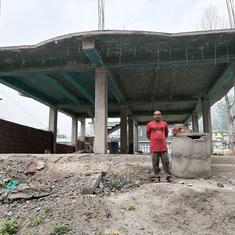The enormous focus on external threats has not, as one might have imagined, helped to develop a cohesive nation-state or national unity, bridging ethnic and political divisions for the sake of defense against India. Within 25 years of its emergence as a nation-state, Pakistan lost its eastern portion of Bengal to secession and war, while the western part has experienced several ongoing subnational autonomy movements. The loss of East Pakistan was largely the result of the efforts by the West Pakistani military and political elite to deprive the eastern side of political and economic autonomy and democratic rights. Granted, external military intervention by India was essential for the bifurcation of Pakistan in 1971. However, fundamentally secession was the result of an excessive focus on military solutions to a political problem: the participation and representation of the large Bengali population.
In 2012, Pakistan is one of the weakest states globally. Its armed forces do not have full control of several parts of the country, especially the northwest areas, with the Taliban forces having occupied over 30% of Pakistani territory in 2009. Pakistan appears among the top of various indexes on state weakness. For instance, the “Failed State Index,” an annual report of most failed states by Foreign Policy magazine, places Pakistan at number 12 in 2011. This was actually a slight improvement from previous years: Pakistan ranked tenth in 2009 and 2010 and ninth in 2008. This index lists countries’ performances in the area of stability on the basis of vulnerability criteria such as refugee flows, poverty, group grievances, factionalism within its elite, the quality of public services, and the capacity of the security apparatus. It should, however, be noted that Pakistan has conventional and nuclear capability sufficient to wage traditional warfare with India, as well as deter its larger neighbor from launching a major attack. Indeed, Pakistan’s capabilities are lopsided: it can hold its own against India but is severely constrained in counterinsurgency warfare at home. Pakistan has also faced major difficulties in overcoming the state-to-nation imbalance – that is, there is a mismatch between the formal territorial state and the national groups living in it. This imbalance has also been exacerbated by the elite’s active support for territorial revisionism within the region, especially vis-à-vis India and Afghanistan. The blowback effects from these efforts have only increased ethnic and communal problems within Pakistan.
Today, powerful warlords control many parts of the country. The central leadership has little sway over the northwestern areas, while extremist Islamic groups such as the Taliban have become key players in the political system. Conflicts between the key sectarian groups, Sunnis and Shias, and by ethnic groups such as Mohajirs (7.57% of the population) and Baloch (3.57%) have made many Pakistani cities like Karachi, Peshawar, and Quetta unsafe for their inhabitants. In addition, key ethnic groups such as the Baloch, Sindhis (14.1%), Pashtuns (15.42%), and Seraikis (8.38%) demand autonomy from the Punjabi dominated (44.68%) country, some more forcefully than others.
What is most puzzling is the insufficiency of Islam as a factor in gluing together the Pakistani society. Neither the national security state approach nor the use of religion has pacified the class and ethnic divisions of Pakistan. Economic benefits have been unevenly divided, making some ethnic groups less successful than others. Most of the ruling class, including the military elite, has always come from the province of Punjab. Before East Pakistan’s secession in 1971, that ruling class showed little interest in improving the conditions of Bengalis. Since then it has similarly neglected a just resolution of simmering conflicts in Balochistan and Sindh, among others. The fiercely independent Pashtun tribes in the northwest were never pacified, and the state has not offered a compelling economic or political model to them. More generally, successive rulers of Pakistan followed policies that negatively impacted political and economic development, integration, and long-term security. As a result, Pakistan has fallen behind many of its peers in Asia and Latin America in the arena of economic development despite showing some signs of progress in the 1960s. In 2012 Pakistan stood at 124 among 144 countries in the global competitiveness index. The 2013 Human Development Report assigns Pakistan the 146th rank out of 186 countries (placing it in the lowest category) on the basis of indicators such as life expectancy at birth, mean and expected years of schooling, and per capita income. It is indeed one of the least globalised countries in terms of the core economic categories of trade and investment.
A deeper understanding of Pakistan’s development has immense policy significance in the age of transnational terrorism and nuclear proliferation; in both areas, Pakistan has emerged as the single-most important source of challenge. Since the 1990s, Pakistan has become the world’s biggest hotbed of transnational terrorism, with the connivance of elements of the state. Since 2001, it has also become the home of al-Qaeda and Taliban forces waging war on the Western coalition protecting the Karzai regime in Afghanistan. It has also posed a major challenge in nuclear proliferation, with the A. Q. Khan network illegally transferring nuclear materials to countries such as North Korea, Iran, and Libya. In 2011 Pakistan possessed some 110 nuclear weapons, making it the fifth largest nuclear weapons state. Yet unlike almost every other nuclear state, there is a potential for state failure and the weapons falling into the hands of Islamic radicals. Understanding why this has happened is important for policymakers everywhere.
The larger implication is that the European example of state building is sui generis and historically contingent, and has serious weaknesses when applied to either non-European contexts or different time periods. Barring exceptional cases, war and war preparation do not make a state strong. At the very least, the connection between war and development of a strong state must be approached with care: war-making states in the contemporary era have prospered in the face of serious security threats, but largely through restraint and refraining from a hypersensitive approach to security. Continuous preparation for war is an unattractive model, especially in comparison to the generally developmental (or trading) state approach that other nations have followed in recent decades. As the Pakistani case shows, if a state fails to innovate, it can become a geopolitical and security nightmare for its neighbors, other states, and – not least – itself. At a minimum, states need to keep security competition under control or – failing that – compartmentalise it to achieve rapid economic growth and political development. At the policy level, decision-makers need to understand better the negative impact of foreign aid, excessive defense spending, and the pursuit of hyper-realpolitik national security policies.
...Ultimately, we need to know why Pakistan has not made it in the modern world as a strong state and why its model of statecraft and development strategy has become archaic and why it needs fundamental rethinking on the part of its elite and its people if it ever wants to emerge as a peaceful state.
Excerpted with permission from The Warrior State: Pakistan in the Contemporary World by TV Paul, Random House India, Rs 499.











